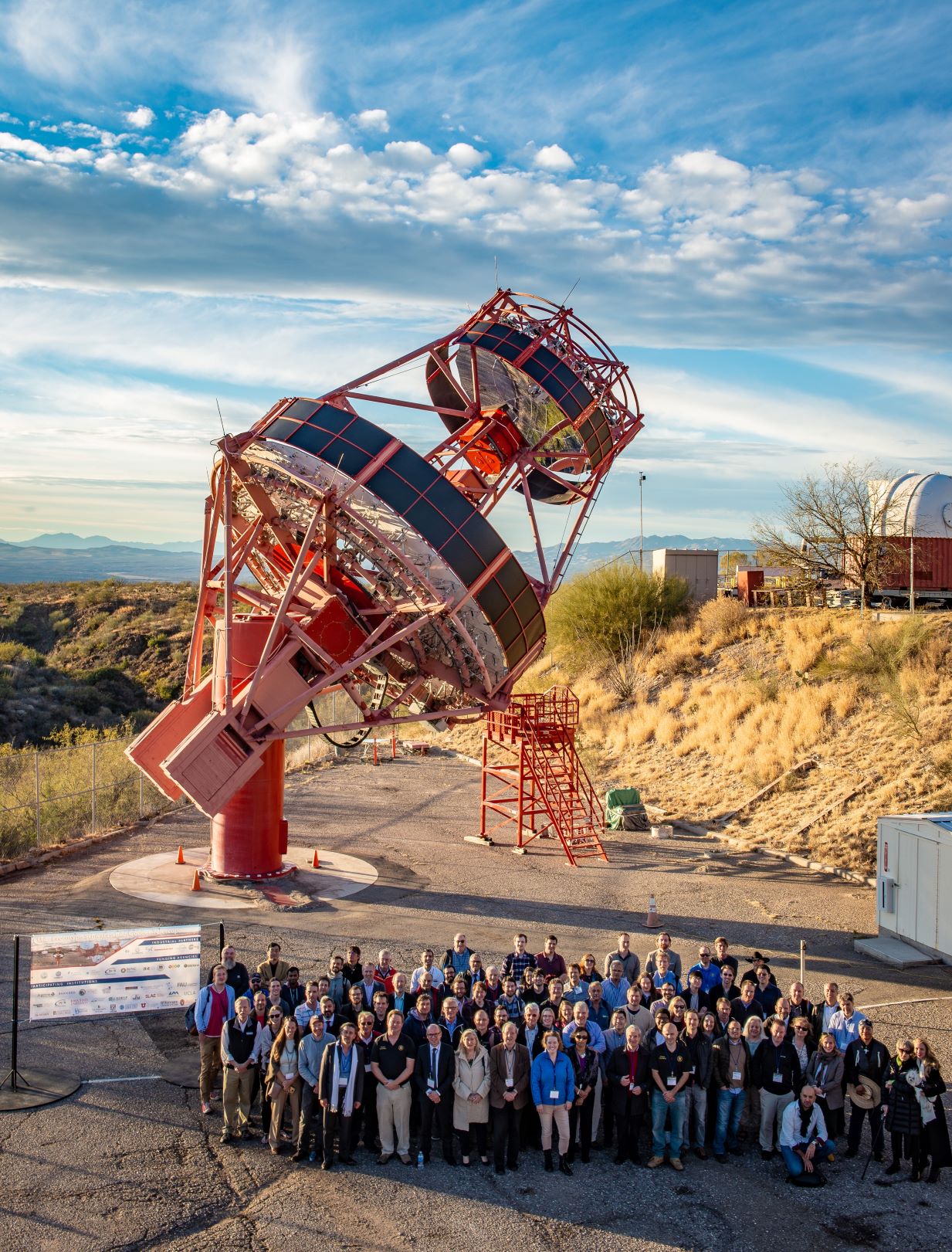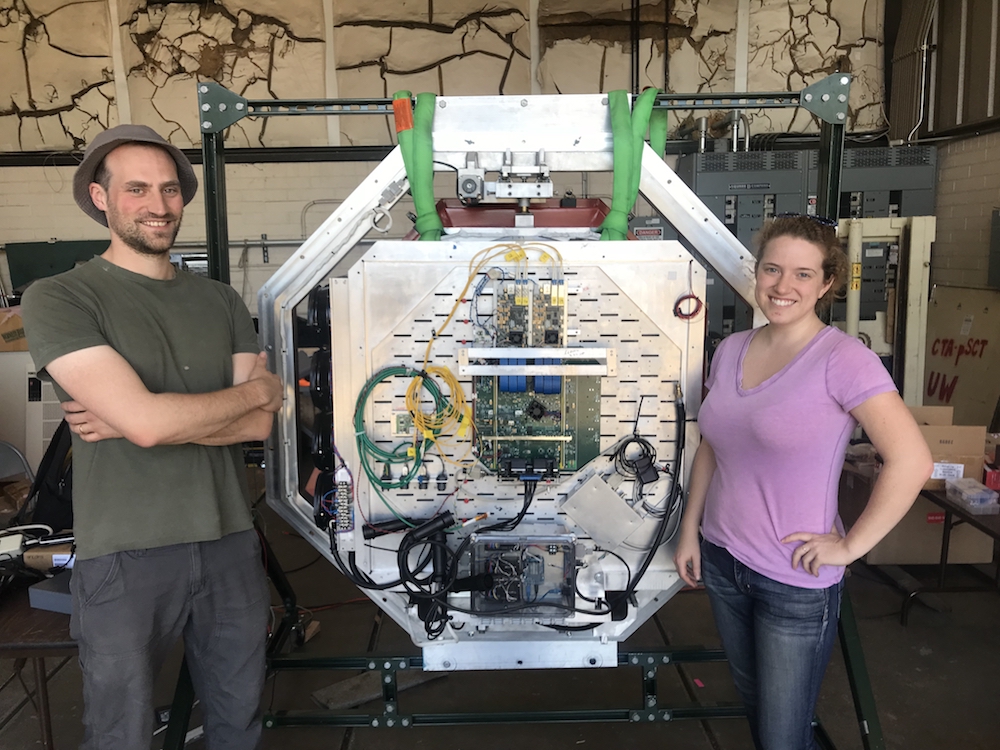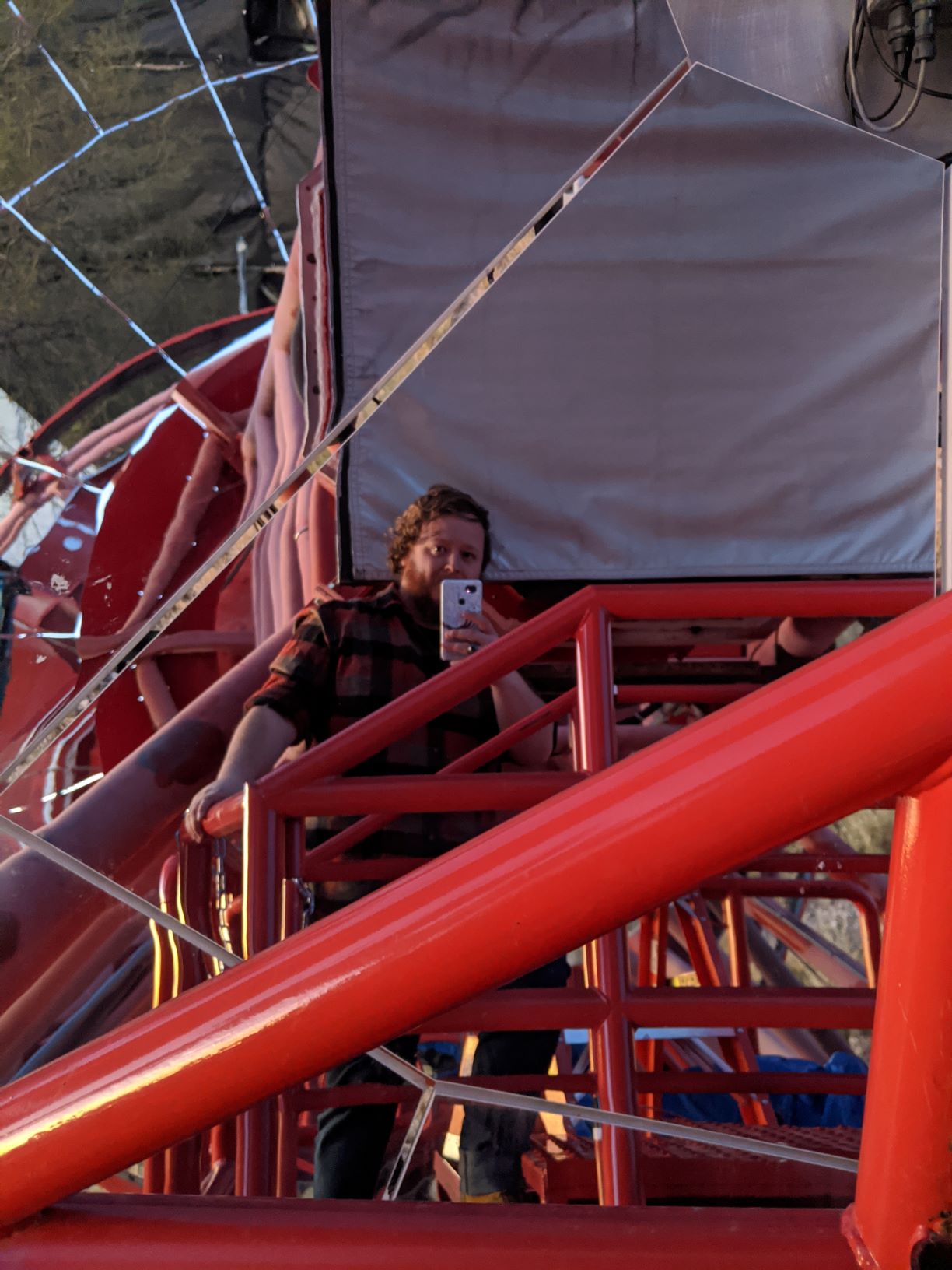UW–Madison scientists play instrumental role in proving viability of innovative gamma-ray telescope

Text adapted from CTA press release.
Scientists in the Cherenkov Telescope Array (CTA) consortium have detected gamma rays from the Crab Nebula using the prototype Schwarzschild-Couder Telescope (pSCT), proving the viability of the novel telescope design for use in gamma-ray astrophysics. The announcement was made today by Justin Vandenbroucke, associate professor at the University of Wisconsin–Madison, on behalf of the CTA Consortium at the virtual 236th meeting of the American Astronomical Society (AAS).
“The Crab Nebula is the brightest steady source of TeV, or very high-energy, gamma rays in the sky, so detecting it is an excellent way of proving the pSCT technology,” says Vandenbroucke, who is also affiliated with the Wisconsin IceCube Particle Astrophysics Center (WIPAC) at UW–Madison. “Very high-energy gamma rays are the highest energy photons in the universe and can unveil the physics of extreme objects, including black holes and possibly dark matter.”
Vandenbroucke is coleader of a team made up of WIPAC scientists and other collaborators that developed and operate a critical part of the telescope: its high-speed camera. Vandenbroucke has worked on the design, construction, and integration of the camera since 2009.
Weighing in at 800 pounds and roughly the size of a golf cart, this camera is not quite the same as the camera on your smartphone. The pSCT camera has a modular design, with 25 modules each containing 64 pixels. It is capable of recording movies at a rate of a billion frames per second, which is necessary to capture the extremely fast flashes of Cherenkov light that are created when gamma rays crash into molecules of air in Earth’s atmosphere.
Thomas Meures, an electrical engineer at WIPAC, led the technical side of the team effort at UW–Madison. As an expert on the entire camera hardware system, he led the team in collecting, testing, debugging, and putting together all of the subsystems necessary to build the camera in the CTA laboratory in UW–Madison’s Chamberlin Hall. They finished assembly and testing of the camera in early May 2018 after several years of work.

The camera was installed on the telescope at the end of May 2018, and the pSCT was inaugurated in January 2019 at the Fred Lawrence Whipple Observatory in Amado, Arizona—the largest field site of the Center for Astrophysics | Harvard & Smithsonian—next to the gamma-ray telescopes that make up the VERITAS (Very Energetic Radiation Imaging Telescope Array System) observatory. A few days later, the pSCT recorded its first light, including its first detection of particle showers.
Leslie Taylor was on site for the inauguration and first light. A UW–Madison graduate student, Taylor has been to the Whipple Observatory many times during the three years she has worked in Vandenbroucke’s group, most recently for a four-month stint between September 2019 and January 2020.
During that stay at the Whipple Observatory, Taylor’s work focused on finishing camera commissioning, which included helping to install the GPS time-tagging system into the back of the camera, installing a new LED flasher, and making safety improvements to the camera access tower. She also worked to develop the camera’s data-taking software and created an on-site observing procedure informed by her experience working on the pSCT and observing for VERITAS. The observing manual she produced details how to operate the telescope and camera, how to observe sources, including the Crab Nebula, and how to run on-site analysis of the data once it has been taken. It is now in use by other pSCT observers.
During her stay, Taylor got to lead the first nights of Crab observations, which she and other CTA scientists began in January 2020 after a year of commissioning work.
“Working onsite in Arizona was extremely rewarding,” says Taylor. “Before working on the pSCT, I would have never dreamed that I would be able to spend all day 30 feet up in a telescope or stay up all night observing the Crab Nebula.”
Once the pSCT had collected data, UW–Madison graduate student Brent Mode led data calibration and analysis. Mode adapted preexisting CTA software to work with pSCT data and prepared camera images using an algorithm for “image cleaning.” Mode also developed methods to calibrate the sensitivity of each camera pixel and to remove noise from the data—an important step since the current electronics in the pSCT camera sometimes takes pictures dominated by electronics noise. A three-year project is underway to upgrade the camera to reduce this noise and expand the area of sky that the camera can view by a factor of seven.

The scientists then used the WIPAC computing cluster to process the data taken while observing the Crab Nebula. Mode worked closely with a University of Delaware professor, Jamie Holder, to remove much of the background signal and achieve the first pSCT detection of the Crab Nebula.
“I’m really excited that we were able to make the first detection with the pSCT,” says Mode. “This has been a major milestone in the project, and it is the first one that I’ve played a major role in as a graduate student.”
Detecting the Crab Nebula with the pSCT is more than just proof positive for the telescope itself. It lays the groundwork for the future of gamma-ray astrophysics. “Gamma-ray astronomy is already at the heart of the new multimessenger astrophysics, and the SCT technology will make it an even more important player,” says Vandenbroucke.
The field of very high-energy gamma-ray astronomy is relatively young, but it has moved rapidly to the forefront of astrophysics. Just over three decades ago, scientists detected the first TeV gamma rays coming from the Crab Nebula on the same mountain where the pSCT sits today. “That was a real breakthrough, opening a cosmic window with light that is a trillion times more energetic than we can see with our eyes,” says Vandenbroucke.
Vladimir Vassiliev, a professor of physics and astronomy at the University of California Los Angeles and principal investigator of the pSCT, first proposed the idea of applying the SCT concept to TeV gamma-ray astronomy nearly 15 years ago. Now, the CTA consortium has established this new technology that will measure gamma rays with extraordinary precision, enabling future discoveries and laying the groundwork for use in the future Cherenkov Telescope Array observatory, which will host more than 100 gamma-ray telescopes.

The initial pSCT Crab Nebula detection was made possible by leveraging key simultaneous observations with the colocated VERITAS. “We have demonstrated that this new technology for gamma-ray astronomy unequivocally works,” says Wystan Benbow, director of VERITAS. “The promise is there for this groundbreaking new observatory, and it opens a tremendous amount of discovery potential.”
“With long projects like this it always feels like it will take forever to make things work the way they should, and then it takes you by surprise when they actually do,” says Meures. “Having this confirmation, that we have been doing the right thing so far, is very encouraging for our upgrade project. It tells us how much more we can do once we have worked out the little shortcomings of our current prototype.”
“I’m proud of the hard work that has gone into this achievement by the whole team,” says Mode, “especially in improving the performance of the camera and understanding the pSCT data, which has been a collaborative effort featuring large contributions from the whole Wisconsin group as well as our collaborators.”
The pSCT was made possible by the contributions of 30 institutions and five critical industry partners across the United States, Italy, Germany, Japan, and Mexico, and by funding through the U.S National Science Foundation Major Research Instrumentation Program. At UW–Madison, the Office of the Vice Chancellor for Research and Graduate Education and the Wisconsin Alumni Research Foundation have supported the project through a UW2020 award.
About the pSCT
The SCT optical design was first conceptualized by U.S. members of CTA in 2006, and the construction of the pSCT was funded in 2012. Preparation of the pSCT site at the base of Mt. Hopkins in Amado, AZ, began in late 2014, and the steel structure was assembled on site in 2016. The installation of the pSCT’s 9.7-m primary mirror surface—consisting of 48 aspheric mirror panels—occurred in early 2018, and was followed by the camera installation in May 2018 and the 5.4-m secondary mirror surface installation—consisting of 24 aspheric mirror panels—in August 2018. Scientists opened the telescope’s optical surfaces and observed first light in January 2019. It began scientific operations in January 2020. The SCT is based on a 114-year-old two-mirror optical system first proposed by Karl Schwarzschild in 1905, but only recently became possible to construct due to the essential research and development progress made at the Brera Astronomical Observatory, Media Lario Technologies Incorporated, and the Istituto Nazionale di Fisica Nucleare, all located in Italy. The pSCT operations are funded by the National Science Foundation and the Smithsonian Institution.
For more information visit https://www.cta-observatory.org/project/technology/sct/.
About CTA
CTA is a global initiative to build the world’s largest and most sensitive very high energy gamma-ray observatory, consisting of about 120 telescopes split into a southern array at Paranal, Chile, and a northern array at La Palma, Spain. More than 1,500 scientists and engineers from 31 countries are engaged in the scientific and technical development of CTA. Plans for the construction of the observatory are managed by the CTAO gGmbH, which is governed by shareholders and associate members from a growing number of countries. CTA will be the first ground-based gamma-ray astronomy observatory open to the worldwide astronomical and particle physics communities.
For more information visit http://cta-observatory.org/.
About the Wisconsin IceCube Particle Astrophysics Center
The Wisconsin IceCube Particle Astrophysics Center, or WIPAC, is a scientific center within the Office of the Vice Chancellor for Research and Graduate Education at the University of Wisconsin–Madison. WIPAC maintains and operates the IceCube detector under a cooperative agreement with the National Science Foundation. Additionally, WIPAC is the hub for the international IceCube Collaboration, made up of more than 300 researchers from 52 research universities and laboratories in 12 countries. It oversees the data analysis grant for all the U.S. collaborating institutions. Besides IceCube, WIPAC is also involved in the Askaryan Radio Array (ARA), the Cherenkov Telescope Array (CTA), the High-Altitude Water Cherenkov (HAWC) Observatory, Dark Matter in Ice (DM-Ice), and the CHerenkov detectors In mine PitS (CHIPS) projects. With this suite of experiments, research at WIPAC covers neutrino physics and astronomy, cosmic rays, dark matter, and gamma ray astronomy.
Project contacts:
University of Wisconsin–Madison
Justin Vandenbroucke
608-890-1477
justin.vandenbroucke@wisc.edu
Center for Astrophysics | Harvard & Smithsonian
Wystan Benbow
617-496-7597
wbenbow@cfa.harvard.edu
University of California, Los Angeles
Vladimir Vassiliev
310-267-5878
vvv@astro.ucla.edu
Media contacts:
Wisconsin IceCube Particle Astrophysics Center
University of Wisconsin–Madison
Madeleine O’Keefe
608-515-3831
press@icecube.wisc.edu
Center for Astrophysics | Harvard & Smithsonian
Fred Lawrence Whipple Observatory
Amy Oliver
801-783-9067
amy.oliver@cfa.harvard.edu
